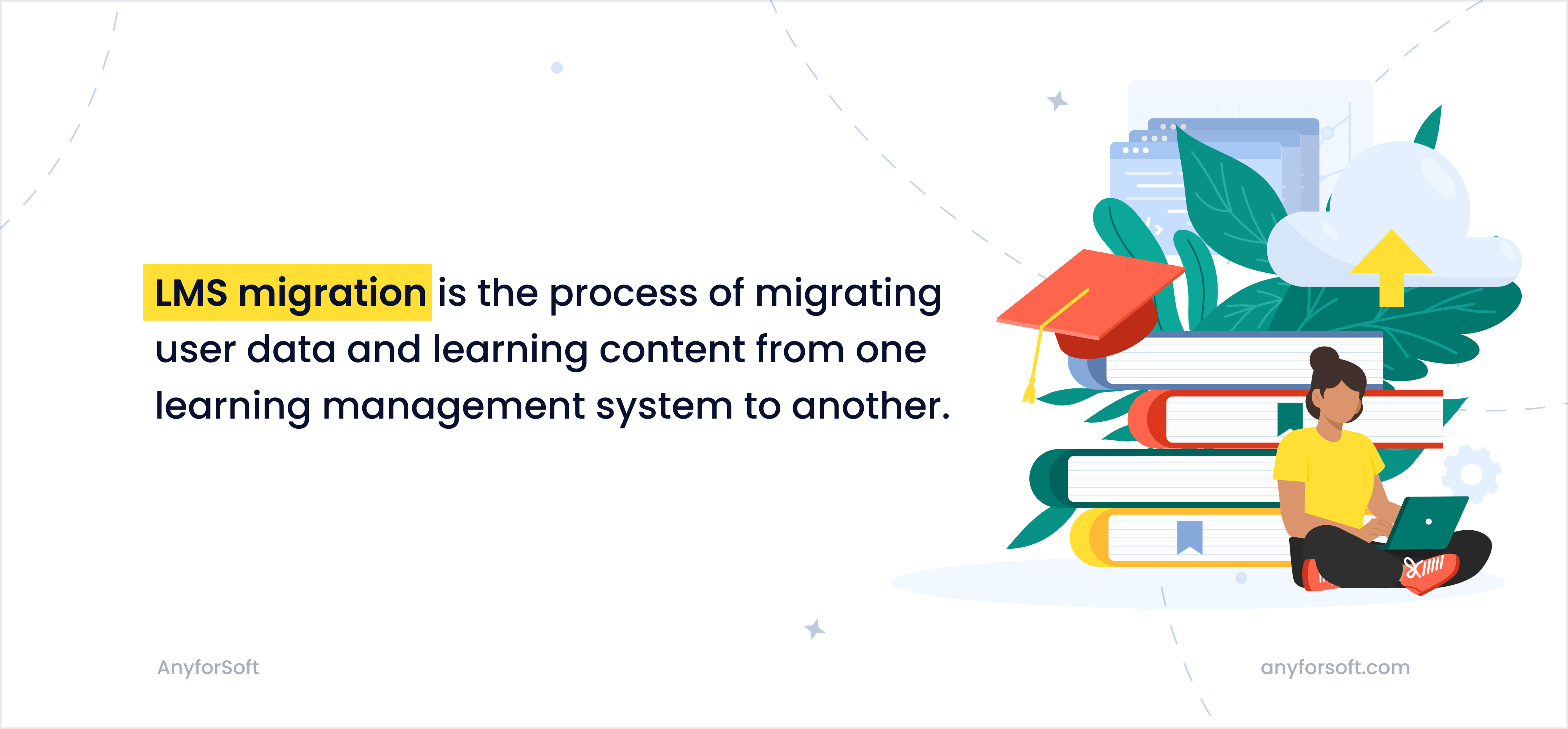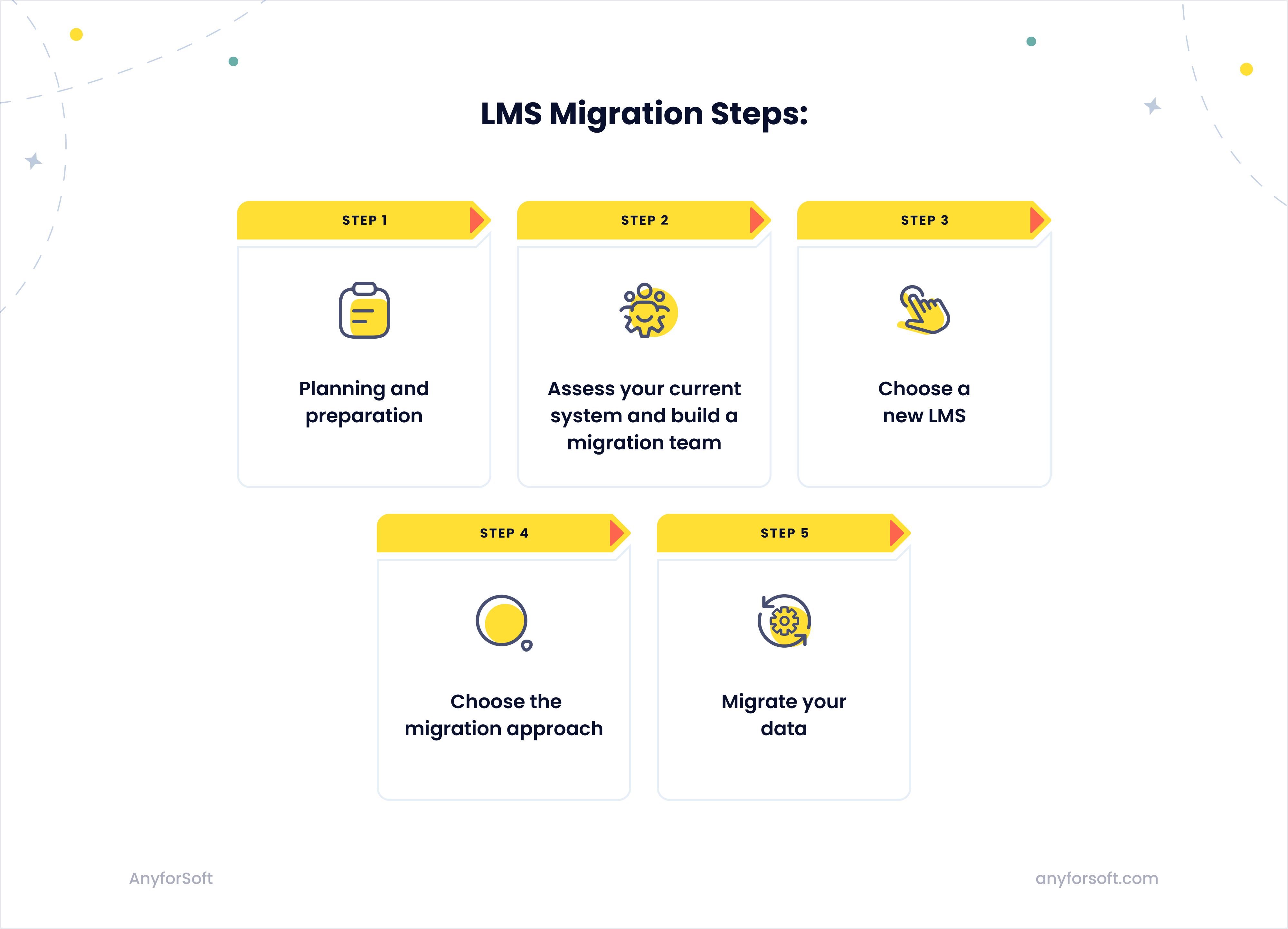Your current LMS no longer satisfies your needs? Then it’s time for LMS migration.
Migrating to a new learning management system (LMS) is a lengthy process that comes with a myriad of challenges:
- You need to ensure a smooth transition of data, avoiding data loss and corruption.
- You must customize and configure your new LMS to meet the unique needs of your organization.
- The new learning platform has to be integrated with other systems you use.
- It also needs to be thoroughly tested to ensure good performance even under heavy loads.
But don’t worry—we have you covered. As a seasoned provider of learning management system development services, AnyforSoft is here to help you move to a new LMS. In the following paragraphs, you will find a step-by-step migration plan that you can utilize to transfer your data with as little friction as possible.
Without further ado, let’s get started!
What is LMS migration?
LMS migration is the process of moving your user data along with learning content from the old LMS to the new one.
Although costly and time-consuming, LMS migration helps businesses solve multiple issues, from poor learning experiences to scalability limitations. It allows them to access the latest e-learning features, enhance the learner experience, seamlessly connect with other enterprise solutions, and scale on demand.
However, there are certain risks associated with the LMS migration process that you should be aware of:
- Risk of data loss or corruption.
- Technical difficulties during or after LMS implementation.
- Resistance from users accustomed to your old LMS.
To avoid potential problems, you should carefully choose your migration team.

Why Do Businesses Switch to a Different LMS?
According to a Brandon Hall Group study, 27% of users are dissatisfied with their current LMS. There are plenty of reasons for that.
Reason 1: They use an outdated LMS
E-learning is a highly dynamic industry that constantly evolves. Machine learning, artificial intelligence, VR and AR—all these features enhance the learning experience and open up new education opportunities. However, some LMSs are built on outdated technologies and can’t support these advanced functions. In such cases, businesses often consider moving to a new LMS platform instead of modernizing legacy applications.
Reason 2: They want to scale
If a business is unlucky enough to choose the wrong LMS provider, it will have a hard time scaling. Many cheap ready-made LMS platforms have poor infrastructures and can’t handle high traffic loads. Moreover, they often provide insufficient data storage and management capabilities, which poses challenges as the volume of learning content increases. Yet another reason why organizations switch to a different LMS vendor, moving to a new LMS.
Reason 3: Their current LMS provides a poor experience
A legacy LMS is not only limited in terms of features and scalability, but it also spoils the user experience due to constant lags and errors. It suffers from long loading times, frequent crashes, an outdated and unintuitive user interface, limited integrations with third-party software, and a lack of personalization. Modernizing such a legacy system is often more expensive and time-consuming than LMS data migration, so businesses opt for the latter.
Reason 4: Their existing LMS has become too expensive
Another reason to move from one LMS to another is cost considerations. An LMS provider may change the subscription price at any moment, rendering its e-learning platform too expensive. Given that startups and small businesses have limited budgets, they will likely transfer to a new LMS in such a case.
How Long Does Migrating to a New LMS Take?
LMS data migration can take anywhere from 2 weeks to several months. Its duration will be dictated by numerous factors:
- Size of your organization.
- Complexity of data to be migrated.
- Availability of resources.
- Customization requirements.
- Technical infrastructure.
- Integration needs.
- Regulatory and compliance requirements.
- Data quality.
Therefore, we can’t say how long the migration process will take in your particular case. To provide you with a time estimate, we have to take a look at your project first. Feel free to contact us through the website form and we will provide LMS consulting services along with a cost estimate.
5 Steps for a Successful LMS Migration
Now that we’ve discussed what migration is about, why users opt for it, and how long it may take, let’s move to the main question of today’s article—how to transfer data from the old system to the new one. This 5-step LMS migration checklist should help.

Step 1: Planning and preparation
Before migrating data to a new LMS, define your objectives and identify problem areas that you aim to solve with migration. Perhaps, your current system doesn’t support the latest features like artificial intelligence and VR. Maybe it can’t integrate with the tools you’re using. Or it could be that it provides a terrible learning experience, hindering effective education.
Write down all your pain points to ensure you address them during the migration process. Also, don’t forget to engage stakeholders (administrators, instructors, IT team, and students/employees) to gather requirements and ensure their needs are met.
Step 2: Assess your current system and build a migration team
Once you’ve written down your pain points and gathered requirements from stakeholders, assess your current system and build a migration team. You should create a detailed inventory of all courses, materials, user data, and integrations in your training platform and get rid of redundant data to streamline the migration process. As for the team, consider these roles:
- Team leader—will be in charge of the migration process.
- Course manager—will be responsible for course data.
- Training administrator—will ensure the new system meets the needs of learners and instructors.
- IT architect—will be responsible for the technical side of migration.
Step 3: Choose a new LMS
Based on stakeholder input and your company’s needs, list the features required in the new LMS. With that list, research and evaluate potential LMS vendors and request software demos if necessary. Take into account pricing, customer testimonials, functionality, scalability, customization capabilities, security, integration options, and performance. Utilize platforms such as Clutch and Capterra to find the most reliable LMS providers.
Here are some examples of the leading solutions in the industry:
- TalentLMS.
- iSpring Learn.
- CANVAS.
- Moodle.
- Rippling.
- Paycor.
You can find even more options in our article on the best enterprise learning management systems.
If your organization has very specific needs that ready-made tools can’t satisfy, consider custom LMS development. Also, check out our article on the difference between custom vs. off-the-shelf software—it will help you decide which option is better for your business.
Step 4: Choose the migration approach
When migrating from an old LMS to a new system, you can opt for two different approaches: migrate all the data in one go (big bang migration) or do it in phases (phased migration). Both options have their pros and cons.
Big bang migration
This approach is fast and can be completed in a shorter time. Since there’s only one migration event, it is easier to manage. However, it entails additional risks and businesses might face significant downtimes if something goes wrong.
Big band migration will suit small organizations and institutions with fewer users and less data.
Phased migration
Phased migration takes a longer time but is less risky, as it enables businesses to solve emerging issues incrementally. It also causes less disruption to business operations. As for the downsides, it requires maintaining two systems until the migration is complete.
Phased migration is best for large businesses and institutions with significant amounts of data and users.
Step 5: Migrate your data
Once all the preparations are done and the migration approach is chosen, migrate your data. Map data fields from the old LMS to the new one to ensure compatibility. Many LMS vendors offer various tools to facilitate the migration process—utilize them to save time and resources. Also, consider conducting a test migration—transfer a small amount of data first to see how it goes and if you face potential issues. Document any problems or discrepancies and make necessary adjustments to the migration plan based on the identified issues. Retest until the process is smooth and error-free.
After migrating the data, allow key stakeholders to review the result to ensure their requirements are met.
Wrapping Up
LMS migration poses many challenges. However, when done right, it opens a myriad of opportunities for your business. By switching to a better platform, you will enhance the learner experience, improve functionality, boost performance and reliability, and, of course, ensure scalability.
So don’t wait until your system becomes too slow—migrate to a new LMS today.
If you need a reliable LMS partner, AnyforSoft will help. As a company with 12 years of expertise in education and e-learning, we successfully deliver projects of any complexity. No matter how many users and gigabytes of data you have, we will seamlessly transfer it to the new environment and make sure everything works correctly.
Contact us today and tell us about your project.
